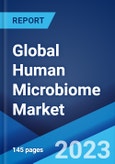The global human microbiome market size reached US$ 679.1 Million in 2022. Looking forward, the market is expected to reach US$ 2,058.5 Million by 2028, exhibiting a growth rate (CAGR) of 20.30% during 2022-2028.
The human microbiome refers to the genes present inside various microorganisms found in the genetic portrait, or metagenome, of humans. It consists of various microorganisms, such as bacteria, fungi, protozoans, non-living viruses and numerous single-celled organisms. These organisms impact human physiology and contribute to the enhancement or impairment of metabolic and immune functions. They are found in the human tissues and are studied for medical advancements and analytical techniques. Microbiomes are utilized in probiotics, prebiotics, pharmaceutical drugs and diagnostic and therapeutic systems for various ailments, such as diabetes, obesity, cancer and metabolic, gastrointestinal, neurological, central nervous system and autoimmune disorders.
The human microbiome refers to the genes present inside various microorganisms found in the genetic portrait, or metagenome, of humans. It consists of various microorganisms, such as bacteria, fungi, protozoans, non-living viruses and numerous single-celled organisms. These organisms impact human physiology and contribute to the enhancement or impairment of metabolic and immune functions. They are found in the human tissues and are studied for medical advancements and analytical techniques. Microbiomes are utilized in probiotics, prebiotics, pharmaceutical drugs and diagnostic and therapeutic systems for various ailments, such as diabetes, obesity, cancer and metabolic, gastrointestinal, neurological, central nervous system and autoimmune disorders.
Human Microbiome Market Trends
The increasing prevalence of chronic lifestyle diseases and infections due to microbial dysbiosis across the globe is one of the key factors driving the market growth. Moreover, the rising geriatric population, which is more susceptible to such ailments, is providing a thrust to the market growth. The growth of the market can also be attributed to the increasing emphasis on the development of human microbiome therapeutics with enhanced efficacy. For instance, human gut microbiomes are being developed in specific combinations for the effective treatment of various gastrointestinal ailments. In line with this, the onset of the coronavirus (COVID-19) pandemic is also providing a thrust to the market growth. Researchers are extensively studying the lung microbiomes to analyze the severity of the infections and develop appropriate therapeutics and vaccines. Additionally, various advancements, such as the development of target-specific microbiome-based therapies, are also favoring the growth of the market. Other factors, including extensive research and development (R&D) activities, along with significant growth in the pharmaceutical industry, especially in the developing economies, are anticipated to drive the market toward growth.Key Market Segmentation
This research provides an analysis of the key trends in each sub-segment of the global human microbiome market report, along with forecasts at the global, regional and country level from 2023-2028. The report has categorized the market based on product, application and disease type.Breakup by Product:
- Probiotics
- Prebiotics
- Diagnostic Tests
- Drugs
- Medical Food
Breakup by Application:
- Therapeutics
- Diagnostics
Breakup by Disease Type:
- Obesity
- Diabetes
- Autoimmune Disorders
- Cancer
- Gastrointestinal Disorders
- Central Nervous System Disorders
Breakup by Region:
- North America
- United States
- Canada
- Asia-Pacific
- China
- Japan
- India
- South Korea
- Australia
- Indonesia
- Europe
- Germany
- France
- United Kingdom
- Italy
- Spain
- Russia
- Latin America
- Brazil
- Mexico
- Middle East and Africa
Competitive Landscape
The competitive landscape of the industry has also been examined along with the profiles of the key players being 4D pharma plc, Atlas Biomed Group Limited, BIOHM, BiomX, Bione, DayTwo Inc., ENTEROME, Ferring B.V., Finch Therapeutics, Second Genome Inc., SynBioBeta LLC, Synthetic Biologics Inc., Vedanta Biosciences Inc. and Viome Inc.Key Questions Answered in This Report:
- How has the global human microbiome market performed so far and how will it perform in the coming years?
- What has been the impact of COVID-19 on the global human microbiome market?
- What are the key regional markets?
- What is the breakup of the market based on the product?
- What is the breakup of the market based on the application?
- What is the breakup of the market based on the disease type?
- What are the various stages in the value chain of the industry?
- What are the key driving factors and challenges in the industry?
- What is the structure of the global human microbiome market and who are the key players?
- What is the degree of competition in the industry?
Table of Contents
1 Preface3 Executive Summary11 Value Chain Analysis13 Price Analysis
2 Scope and Methodology
4 Introduction
5 Global Human Microbiome Market
6 Market Breakup by Product
7 Market Breakup by Application
8 Market Breakup by Disease Type
9 Market Breakup by Region
10 SWOT Analysis
12 Porters Five Forces Analysis
14 Competitive Landscape
Companies Mentioned
- 4D pharma plc
- Atlas Biomed Group Limited
- BIOHM
- BiomX
- Bione
- DayTwo Inc.
- ENTEROME
- Ferring B.V.
- Finch Therapeutics
- Second Genome Inc.
- SynBioBeta LLC
- Synthetic Biologics Inc.
- Vedanta Biosciences Inc.
- Viome Inc.
Methodology

LOADING...
Table Information
| Report Attribute | Details |
|---|---|
| No. of Pages | 145 |
| Published | November 2023 |
| Forecast Period | 2022 - 2028 |
| Estimated Market Value ( USD | $ 679.1 Million |
| Forecasted Market Value ( USD | $ 2058.5 Million |
| Compound Annual Growth Rate | 20.3% |
| Regions Covered | Global |
| No. of Companies Mentioned | 14 |









